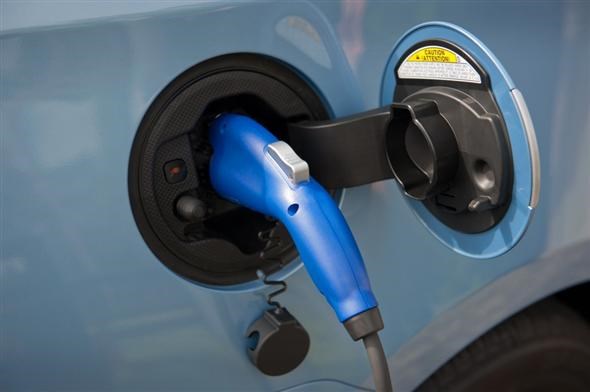The Toyota Prius has been at the forefront of the ‘green’ motoring offensive with its cars’ low emissions and impressive fuel economy claims. The new Prius Plug-in moves the game on even further with CO2 emissions of 49g/km and a claimed average fuel economy of 134.5mpg.
Certainly these are impressive statistics but they are only half the story. This five-door hybrid is the first production Toyota that you can charge from the mains but you won’t suffer from any ‘range anxiety’ issues, thanks to the inclusion of a petrol engine.
Like the standard Prius this is a petrol/electric hybrid but, instead of a normal nickel metal-hydride battery to store electric power, it has a lithium-ion battery underneath its boot floor. This means that it can travel up to 15 miles on electric power alone, at speeds of up to 51mph, without using the petrol engine.
Since two thirds of UK commutes cover less than 12.5 miles you could potentially drive entirely on electric power for pretty much all of your journeys. This would seriously cut fuel bills, particularly when you consider that the Prius Plug-in only takes an hour and a half to fully charge. You’re also talking pence, rather than pounds, to top up the battery.
The other real advantage is that its CO2 emissions are 49g/km but, more importantly, zero if you travel on electric power alone. If you live in a city centre you get all manner of benefits such as free parking, free electric charging on charging points and the bonus of paying nothing to enter congestion charging areas.
So, what’s the catch? Well, the Plug-in costs around £6,000 more to buy than the standard Prius, even when you factor in a £5,000 government grant for electric vehicles.
With a purchase price of £27,895 (with the grant, but extra added on for leather upholstery) you have to be seriously committed to the cause – particularly when you know you could get a perfectly frugal five-door Kia cee’d diesel for about £16,000.
Still this isn’t about cost necessarily, this is about making a statement about your responsibilities towards the environment and you must accept that this is a heavy price to pay. The fact that the Prius Plug-in include niceties such as a fancy sound system and sat-nav with traffic information updates and internet connectivity might soften the blow.
To drive, the Prius Plug-in is what you might call satisfactory. It’s powered by a 1.8-litre four-cylinder 98bhp petrol engine and an electric motor which generate a total power output of 134bhp. It accelerates from 0-62mph in 10.7 seconds and will go on to a top speed of 112mph, which is about right for a half-decent medium hatchback.
In terms of handling the Prius Plug-in is pretty much the same as the Prius. It weighs 50kg more and uses the same steering and suspension components but they have been adjusted to allow for the car’s extra weight. As a result the handling is almost identical, despite the Prius Plug-in’s lithium-ion batteries located under the boot floor.
The car has three driving modes: HV, EV and EV-City. In HV mode it operates in the same way as the standard Prius with the petrol engine kicking in when more power is required. In EV electric-only mode the driver can only travel up to 15 miles and up to 51mph. In EV-City mode the driver has to be more forceful with the throttle until the petrol motor kicks in. This really is a more laconic system designed to maximise the time you are in full electric mode.
There’s also an eco driving mode which is exactly the same as the one found in the standard Prius. This essentially dulls the throttle response and adjusts the air-con settings so you can get maximum fuel economy.
In normal hybrid mode the claimed average fuel consumption is 76.4mpg, which is around 4mpg more than the standard hybrid Prius. At best you’ll cover around 700 miles on a full tank, ideal for those who have to drive long distances regularly.
The dual-zone dashboard on the Prius Plug-in is the same as standard model, except that it gets some silver trim and Plug-in Hybrid logo. There an EV driving ratio indicator that shows what proportion of a journey has been covered on electric power alone. The display also shows the amount of fuel used and how much has been saved by using electricity from external charging. There’s a neat little bar graph showing average monthly fuel consumption and a calendar too.
Toyota has also seen fit to show a rather novel ‘forest’ display. This converts the amount of electricity sourced from external charging into a reduction in CO2 emissions. For every 10kg one tree is planted in a forest and if you are a habitual electric-only driver you’ll get more flowers, trees and animals added to your display.
Admittedly this is not for those who live in cramped built-up areas. If you opt for the Plug-in you’ll need to have a driveway or some facility that allows you to charge the car up. Toyota has a deal with British Gas who, after a survey, may recommend that you have a special wall socket fitted for around £300. Of course, you can arrange this with other suppliers.
The new Toyota Prius Plug-in is available to order now for £27,895, inclusive of the government grant
To read the full Toyota Prius review click here.


Also consider:
Vauxhall Ampera
A range extender that could potentially yield 235mpg. More likely you’ll get around 70mpg if you’re careful.
Nissan LEAF
The LEAF is a fully electric car that has a range of around 100 miles. It is nice to drive with plenty of torque.
Renault Megane
Go for the sub-100g/km diesel. Ok, so it’s not a hybrid or a plug-in, but it has a good chance of acheiving its claimed average economy of 80mpg.





